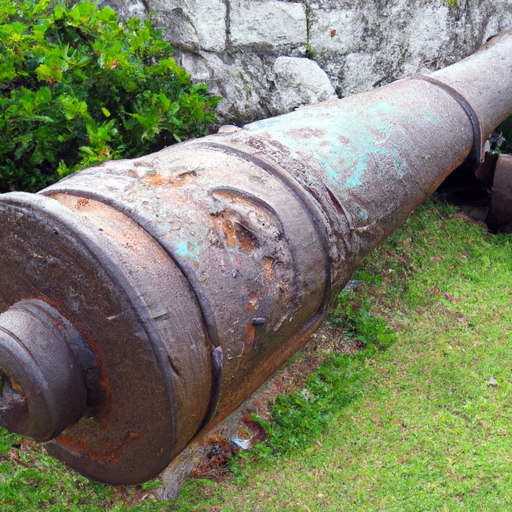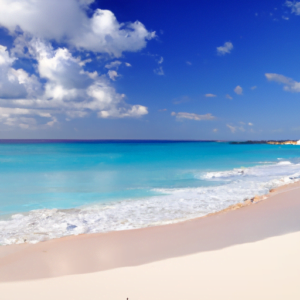Are you fascinated by history and eager to delve into the past? Look no further than the enchanting island, known for its rich Bermuda fortifications that have stood the test of time. Embark on a remarkable journey through history as you explore the diverse range of forts and battlements that dot the island’s stunning landscape. From the grandeur of Fort St. Catherine to the strategic defense of Fort Hamilton, each of these fortifications tells a unique story and offers a glimpse into Bermuda’s fascinating past. Join us as we uncover the hidden gems of Bermuda’s military history and reveal the must-visit fortifications that every history aficionado should have on their itinerary.
Table of Contents
ToggleEarly Bermuda Fortifications
Introduction to Bermuda fortifications
Bermuda, a picturesque island located in the North Atlantic Ocean, is not only known for its stunning pink sand beaches and vibrant marine life but also for its rich history as a strategic military outpost. Throughout the centuries, various defensive structures were built on the island to protect its shores and inhabitants from potential invasions. These fortifications stand as a testament to Bermuda’s past and offer visitors a unique opportunity to delve into its fascinating history.
The first defensive structures in Bermuda
The construction of Bermuda’s defensive structures dates back to the early 17th century when the island was initially settled by the English. Recognizing the strategic importance of Bermuda’s location, the settlers wasted no time in fortifying their newly acquired territory. The first fort, known as Castle Island Fort, was established in 1612 and marked the beginning of Bermuda’s long history of defensive fortifications.
The significance of early forts
The early forts of Bermuda played a crucial role in safeguarding the island from potential threats. They were designed to protect the island’s harbors, control access points, and serve as a deterrent to any hostile forces. These forts also served as centers of power, where the ruling British military forces operated and maintained control over the island. Over time, the construction and improvement of these forts became a testament to Bermuda’s complex naval history and the importance of the island in international trade and defense.
Historical Highlights of Bermuda’s Fortifications
The impact of colonization on fortification construction
As Bermuda became an important colonial outpost for the British Empire, the need to protect the island from rival European powers and potential pirate attacks became more pressing. Consequently, the colonization of Bermuda led to a surge in fortification construction. From the 17th to the early 18th century, several forts were built, including Fort St. Catherine, Fort Hamilton, and Fort Scaur, to enhance the island’s defenses and secure its lucrative position in the Atlantic trade routes.
The role of fortifications during the American Revolutionary War
During the American Revolutionary War in the late 18th century, Bermuda’s fortifications played a vital role in the defense of the island against American privateers and naval forces. Forts such as Fort George and Fort Barrington were integral in repelling attacks and ensuring the safety of the island’s inhabitants. The strategic positioning of the forts and the skillful tactics employed by the British military prevented any successful American invasion attempts, solidifying Bermuda’s reputation as a formidable fortress.
Fortifications during the War of 1812
The War of 1812 between the United States and the British Empire brought renewed importance to Bermuda’s fortifications. With the threat of American aggression looming, the British forces further strengthened the island’s defenses. Fort Albert, Fort Frederick, and Fort Victoria were constructed during this period to fortify critical points along the coastline and deter any potential attacks. The fortifications successfully repelled American attempts to capture Bermuda, serving as a testament to their strategic significance.
The Bermuda Garrison and Its Fortifications
Overview of the Bermuda Garrison
The Bermuda Garrison, established in the 19th century, formed the backbone of Bermuda’s defensive network. It consisted of a series of strategically positioned forts and military installations that spanned the island. The garrison served as a command center for British forces and coordinated the defense of Bermuda’s shores.
Major fortifications within the Bermuda Garrison
Within the Bermuda Garrison, several major forts played pivotal roles in protecting the island. Fort St. Catherine, Fort Hamilton, Fort George, and Fort Barrington were among the most notable fortifications within the garrison. These forts were strategically positioned to cover key approaches and guarded vital coastal areas, ensuring the island’s safety against potential threats.
The architectural features of the garrison forts
The forts within the Bermuda Garrison showcased distinctive architectural features that reflected the military engineering prowess of the era. Many forts boasted thick stone walls, casemates, and bastions that provided sturdy defenses against enemy attacks. These architectural elements were not just practical but also aesthetically pleasing, adding to the charm and historical significance of Bermuda’s fortifications.
Fort St. Catherine
History and significance of Fort St. Catherine
Fort St. Catherine, located at the northeastern tip of Bermuda, holds a prominent place in the island’s military history. Built in the early 17th century, the fort served as a defensive stronghold against potential invaders and played a key role during various conflicts. Its strategic position overlooking the entrance to St. George’s Harbor afforded it unparalleled views and control over the vital shipping lanes.
Exploring the different areas of the fort
Visitors to Fort St. Catherine have the opportunity to explore various sections of the fort. The well-preserved ramparts, gun emplacements, and the iconic stone keep provide an insight into the fort’s defensive capabilities and architectural design. Walking along the walls, visitors can envision the soldiers who once patrolled and defended this historic landmark.
Exhibits and artifacts found in Fort St. Catherine
Fort St. Catherine also houses a museum that showcases a collection of artifacts and exhibits, allowing visitors to delve further into the fort’s history. Displays of ancient weaponry, military uniforms, and historical documents provide a deeper understanding of the fort’s role in Bermuda’s past. The museum offers an immersive experience, bringing to life the stories of the soldiers who protected the island.
Fort Hamilton
The establishment and purpose of Fort Hamilton
Situated on the outskirts of Hamilton, Bermuda’s bustling capital city, Fort Hamilton was established in the late 19th century to enhance the island’s defenses during a period of heightened international tensions. The fort acted as a key defensive structure, protecting Hamilton Harbor and ensuring the safety of the city’s residents and British military personnel stationed on the island.
Notable features and defensive strategies
Fort Hamilton’s impressive architectural features, including its imposing walls and intricate bastions, are a testament to its defensive capabilities. The fort utilized innovative strategies such as cross-fired batteries and strategically positioned gun emplacements to deter potential attackers. These defensive features ensured that Fort Hamilton was well-prepared for any assault.
Panoramic views and recreational activities at Fort Hamilton
Aside from its historical and military significance, Fort Hamilton offers visitors breathtaking panoramic views of the surrounding coastline and the city of Hamilton. The fort’s location on a hill provides an ideal vantage point for capturing stunning photographs and enjoying the natural beauty of Bermuda. Additionally, the fort’s grounds provide ample opportunities for recreational activities such as picnicking and strolling through the well-maintained gardens.
Fort Scaur
The construction and design of Fort Scaur
Located in the western parish of Sandys, Fort Scaur is a remarkable example of Bermuda’s military engineering. Constructed in the mid-19th century, the fort was designed to protect the nearby Dockyard and Royal Naval establishment. The imposing walls and strategic positioning of Fort Scaur exemplify the island’s commitment to fortification during this period.
Exploring the unique tunnels and ramparts
Visitors to Fort Scaur can embark on a fascinating journey through its underground tunnels and explore the fort’s ramparts. The tunnels, ingeniously constructed, provide an intriguing glimpse into the life of soldiers stationed at the fort. Venturing onto the ramparts offers visitors a chance to appreciate the commanding views of the ocean and the tranquil surroundings.
Enjoying the beauty of the surrounding park
Fort Scaur enjoys a picturesque setting within Scaur Hill Park, which adds to the charm and appeal of this historic site. Visitors can take in the serene beauty of the park, stroll along its well-maintained pathways, and relax amidst nature. The park’s lush greenery, colorful flowers, and panoramic views make it an ideal spot for a leisurely afternoon picnic or a peaceful moment of contemplation.
Fort George and the Keep
Overview of Fort George
Fort George, located in St. George, Bermuda’s historic town, stands as a testament to the island’s military heritage. Originally built in the early 17th century, the fort underwent numerous modifications and expansions over the years to meet the changing needs of Bermuda’s defense. Fort George played a crucial role in guarding the entrance to St. George’s Harbor and protecting the town from potential attacks.
The architectural elements of the Keep
One of the most distinctive features of Fort George is its well-preserved Keep, also known as the Citadel. The Keep showcases the architectural brilliance of the time, featuring a central courtyard, underground magazine, and barracks. The stone walls and bastions of the Keep provide a fascinating glimpse into the past, transporting visitors back to the era of colonial Bermuda.
The role of Fort George in Bermuda’s history
Fort George played a crucial role in Bermuda’s history, witnessing significant events and playing a part in numerous conflicts. From repelling attacks during the American Revolutionary War to serving as a key defense post during both World Wars, the fort’s walls have withstood the test of time. Today, Fort George stands as a cherished cultural heritage site, encouraging visitors to learn about Bermuda’s past and appreciate its enduring historical significance.
Fort Barrington
The strategic location of Fort Barrington
Strategically positioned on the picturesque island of St. David’s, Fort Barrington commands a dominant position at the entrance to Ferry Reach, a vital waterway within Bermuda. The fort’s location allowed it to control access to the island’s interior and defend against potential incursions.
Defending against the Spanish invasion attempts
During the 17th century, the Spanish had their sights set on Bermuda as they sought to expand their colonial territories. Fort Barrington played a critical role in fending off Spanish invasion attempts, successfully thwarting several attacks and safeguarding Bermuda’s sovereignty. The fort’s strategic positioning and effective defensive measures made it a formidable obstacle for any would-be invaders.
Current state and visitation details
Today, Fort Barrington stands as a silent sentinel, a reminder of Bermuda’s rich history and the island’s determination to defend its shores. While the fort is not open to the public, visitors can still admire its impressive exterior and take in the scenic beauty of its surroundings from a distance. Ferry Reach Park, situated nearby, offers a prime vantage point to appreciate the fort’s architectural splendor and enjoy a peaceful day in nature.
Fort Albert
The role of Fort Albert in coastal defense
Nestled on the western coast of Bermuda, Fort Albert played a vital role in protecting the island’s coastline from potential naval threats. Constructed in the late 19th century, the fort served as a key defense structure during a time of rising tensions and the emergence of new military technologies.
Features and layout of Fort Albert
Fort Albert, characterized by its imposing walls and commanding presence, was designed with the latest advancements in military engineering. The fort’s layout includes a central parade ground, barracks, and gun emplacements. These features were strategically positioned to maximize the fort’s defensive capabilities while ensuring the safety of the soldiers stationed there.
Exploring the nearby Nature Reserve
Adjacent to Fort Albert is a sprawling Nature Reserve that offers visitors the opportunity to explore Bermuda’s scenic beauty. Walking trails wind through lush vegetation, leading to panoramic vistas overlooking the island’s western coast. Visitors can fully immerse themselves in Bermuda’s natural surroundings, taking in the sights and sounds of this tranquil sanctuary.
Other Remarkable Fortifications in Bermuda
Fort Frederick
Located in the heart of Bermuda’s capital city of Hamilton, Fort Frederick served as a crucial defensive structure during the late 19th century. While the fort is no longer intact, its fascinating history and significance remain an integral part of Bermuda’s fortification legacy.
Fort Langton
Strategically positioned at the entrance to the Great Sound, Fort Langton protected Bermuda’s vital waterways. Although the original fort has been lost to time, its historical importance is recognized, and efforts have been made to preserve its memory for future generations.
Fort William
Situated on the scenic island of Ireland Island, Fort William played a significant role in the defense of Bermuda’s Dockyard. The fort’s unique architecture and rich military history make it a captivating destination for history enthusiasts and visitors alike.
Fort Victoria
Located on a picturesque outcrop overlooking Castle Harbor, Fort Victoria stands as a testament to Bermuda’s early military fortifications. Visitors can explore the ruins of this historic structure and marvel at its strategic positioning and stunning views.
Fort Smith
Nestled within the expansive Admiralty House Park, Fort Smith holds a prominent place in Bermuda’s military history. While the fort is no longer fully intact, its remnants provide a glimpse into the island’s past and offer visitors an opportunity to reflect on its historical significance.
In conclusion, Bermuda’s rich fortifications offer a fascinating journey through history and a chance to explore the island’s unique military heritage. From the early defensive structures to the well-preserved forts within the Bermuda Garrison, each fortification tells a story of Bermuda’s strategic importance and its determination to defend its shores. Whether one is captivated by the architectural features, the historical significance, or the panoramic views, a visit to Bermuda’s forts and battlements promises an enriching experience that combines history, natural beauty, and a glimpse into the island’s proud past.





